what is the first thing you need to do to add one-ninth +start fraction 5 over 6 end fraction ?
Welcome to our fraction figurer, a really versatile tool. It tin:
➕ add,
➖decrease,
✖️multiply, and
➗split
any ii fractions. Moreover, it has the ability to simplify a fraction (A.G.A. reduce), also as tell you how to turn a fraction into decimal, and vice versa. If y'all're yet not impressed, this tool not merely works on standard proper and improper fractions, but also on mixed fractions - what more could you ask for?😁
As usual, nosotros've prepared some introductory reading, which will let you dig into the globe of fractions🌎. Below you'll read virtually the fraction definition, the types of fractions (proper, improper, mixed), and all those basic operations on simple and mixed fractions. Are you ready?
What is a fraction? Fraction definition
A fraction represents the number of equal parts of a whole affair.
Yous can recognize a simple fraction because information technology has ii numbers separated by line (or slash):
- We phone call the top number the numerator, and write it to a higher place the line. It tells us
How many parts we have
- We call the bottom number denominator, and brandish information technology below the line. It means
The total number of parts
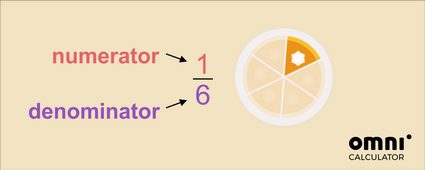
In the example above, information technology'southward one function out of six slices, which the pie was cut into in total. We read it every bit ane-sixth of the whole pie.
Merely, of grade, the cake can exist cut differently!
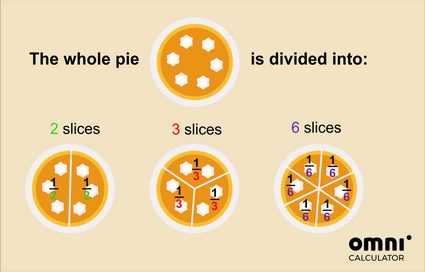
So, if you cut the pie in 2, so one piece is one-one-half of the whole. If y'all cutting the pie in 3 parts, then ane slice is one-third of the whole pie, etc.
Fractions are used all around us:
- every time you want to express part of a whole item, which tin can be divided into even pieces: similar a cake🍰, a chocolate bar🍫, a watermelon🍉, a pizza🍕, etc;
- when nosotros measure something📏, especially in inches or eights of an inch; and
- your figurer screen size 🖥️ is expressed as a ratio, e.1000. 16:9 - and it's likewise a fraction, merely written in a different way. (For information on how to simplify ratios, check out our ratio calculator!)
What is a proper, improper, and mixed fraction?
Then, at present that y'all know the fraction definition, permit'southward have a look at the dissimilar types of fractions. In full general, we accept three types of fractions: proper, improper and mixed fractions:
- Proper fraction
In proper fractions, the peak number (numerator) is smaller than the bottom number (denominator). Information technology means that information technology will always be less than ane whole thing, e.g.:
🍰 v slices of cake out of a cake that was cut into 6;
🍫 2 rows of a chocolate bar out of the whole chocolate bar, which has five rows; and
🍊 7 parts of an orange out of the entire orange, that nosotros cutting into 8.
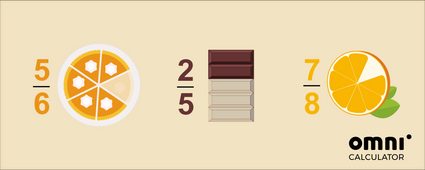
The general dominion, which works for both positive and negative numbers, is that the accented value of the fraction is less than one:
|numerator/denominator|< i
- Improper fraction
And so what is an improper fraction? It's a fraction where the numerator is larger than (or equal to) the denominator. Improper fractions are sometimes called peak-heavy fractions. Examples of improper fractions are:
🍰 10 slices of cake, when each cake has vi slices;
🍫 eight rows of a chocolate bar. A whole chocolate bar has 5 rows; and
🍊 21 parts of orange, if we cut each orange to eight equal pieces.
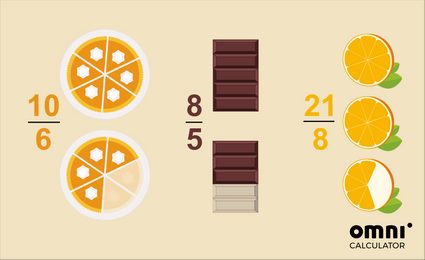
- Mixed fraction
Mixed fractions, also known as mixed numerals or mixed numbers, are another fashion of expressing an improper fraction.
They are whole numbers (the amount of whole things) and a proper fraction put together. Then, if we'll take a look at the examples from the previous paragraph:
🍰 10 slices of cake, when each block has 6 slices is the aforementioned equally → 1 whole block and iv slices out of vi;
🍫 eight rows of chocolate when the whole chocolate bar has 5 rows → one whole chocolate bar and 3 rows out of 5; and
🍊 21 parts of orange, if we cut the orange to 8 slices → 2 whole oranges and five slices out of 8
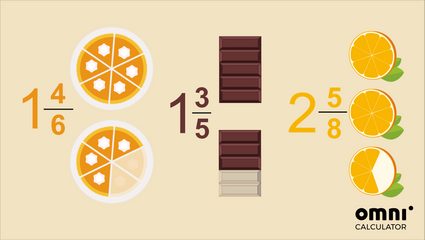
💡 The about important things to remember after reading this section:
• A proper fraction has a smaller top number (numerator) than its bottom number (denominator);
• An improper fraction's numerator is larger than (or equal to) its denominator; and
• A mixed number consists of a whole number and a proper fraction.
How exercise you add fractions? ➕ Calculation fractions rules
When it comes to adding fractions, there are three scenarios:
- The denominator (bottom number) is the same in both fractions - e.g., 3/5 and one/v
This is the nigh straightforward case; all yous need to exercise is to add together numerators (top numbers) together and leave the denominator equally is, due east.chiliad:
3/five + 1/5 = (three + ane)/v = 4/five
- The fractions have unlike denominators - e.m., two/5 and 3/x
This is a bit more of a complicated case - to add these fractions, you demand to observe the mutual denominator.
- You can use due east.g. LCM - the least common multiple to find the common number of your two denominators:
LCM(five,10) = 10
The other selection is to multiply your denominators and reduce the fraction later.
- Then, you need to expand each fraction, to have this common denominator as its bottom number:
And then, y'all should multiply the fraction with the denominator equal to 5 (our i/5) by 2 to get 10 (remember that you must multiply both top and lesser numbers):
2/5 = (ii * ii)/(5 * ii) = 4/ten
Your second fraction has already its denominator equal to 10:
three/10
- Now that your fractions have the aforementioned denominator, y'all can add them:
4/10 + 3/10 = (four + 3)/10 = 7/10
- You want to add ii mixed fractions - due east.g. 2 three/five and one one/2
I solution for this kind of trouble is to convert the mixed fraction to an improper fraction and sum it equally usual.
- Let's convert it for two 3/five
- Multiply the whole number by the denominator:
2 * 5 = 10
- Add the upshot to you numerator:
ten + iii = thirteen
- That'south your new numerator - write it on top of your denominator:
ii 3/v = xiii/5
Analogically, you tin can observe out that 1 1/2 = iii/2
- Practise the standard addition of fractions with uneven denominators:
13/five + 3/2 = 26/10 + fifteen/ten = 41/ten
- Finally, you can convert your result back into a mixed fraction:
Do long partition with a residue:
41/10 = 4 R i
So
41/10 = 4 1/10
Of course, our fraction calculator deals with all of these scenarios. 😎
If you're even so wondering how calculation fractions works, maybe this visual volition assistance?
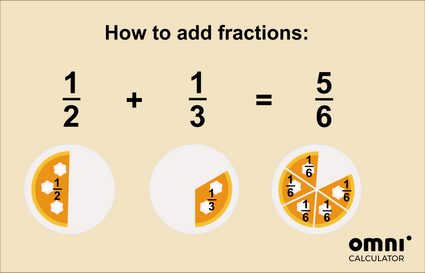
For an even more thorough explanation, cheque out our adding fractions figurer.
How to subtract fractions ➖
If you're wondering how to decrease fractions, and you've read through the previous section , we have some adept news for you: it's pretty much the same!
- If you have fractions with the aforementioned denominator, subtract the numerators:
3/5 - 1/5 = (3 - 1)/5 = 2/5
- When subtracting fractions with unlike denominators - 2/v and 3/10 - repeat the process from the previous section, but subtracting, not adding in the final step:
- Discover a common denominator - it's 10.
- Aggrandize the fractions to their equivalent fractions with a common denominator: 4/10 and 3/10.
- Subtract the numerators.
2/5 - 3/10 = 4/ten - 3/10 = 1/10
- For mixed fractions (two iii/5 and i one/2):
- Change the mixed fractions to improper fractions, every bit before
two 3/5 = xiii/5 and ane i/two = three/2
- Subtract the ii improper fractions with unequal denominators:
xiii/5 - 3/2 = 26/ten - 15/10 = 11/ten
- Get out information technology in an improper fraction, or convert it dorsum to a mixed fraction:
eleven/10 = one R 1 so eleven/10 = 1 ane/10
Yous can imagine subtraction equally taking or eating role of the cake:
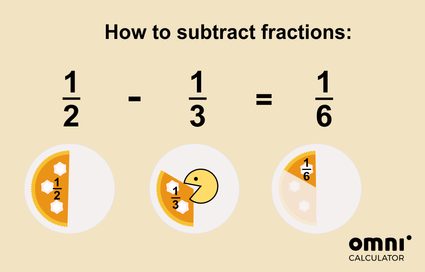
That wasn't so hard, was information technology?
How practise y'all multiply fractions ✖️
Multiplying fractions is - fortunately - an effortless operation. It's numerator times numerator over denominator times denominator. Sometimes you also demand to simplify the fraction. And that'south information technology!
Take a look at this example:
2/3 * 5/half-dozen = (2 * 5)/(3 * half-dozen) = ten/18
which you can then simplify to 5/9
Whenever you deal with mixed fractions, don't forget than you must always write them every bit an improper number before multiplying:
2 ane/2 * three 1/4 = 5/2 * xiii/four = (5 * thirteen)/(2 * 4) = 65/8 =
8 1/8
And when multiplying a fraction by a whole number, remember that yous tin write the whole number as itself divided by one:
3 * five/7 = 3/ane * 5/vii = (3 * 5)/(1 * 7) = 15/7
If you don't know how to bargain with fraction reduction, scroll downwardly to the section .
At present that you know how do y'all multiply fractions, let'southward proceed to the side by side topic, fraction sectionalization.
How to split up fractions ➗
Racking your brain over how to divide fractions? Have no worries! The sectionalisation of fractions is quite similar to fraction multiplication. The simply difference is that you must multiply your kickoff number by the reciprocal of the second fraction. It may sound a bit weird, just it's really elementary! Have a look at this instance:
(1/2) / (iii/v) = one/2 * five/3 = (1 * 5)/(2 * three) = five/vi
So, all you lot demand to practise is turn the second fraction upside down (which is its reciprocal) and multiply the fractions. Sometimes, you may also need to do some fraction reduction. And that's all, tadaaa!🎉
How to simplify fractions?
We always like to brand our lives simpler - even in maths. That's why simplifying fractions is such an important thing. It means that we write the fraction in its simplest possible form. We also phone call simplifying fractions reducing fractions.
Merely what does this mean, exactly? Have a look at these examples:
- You'd rather say that one-fourth (a quarter) of the pizza is left, instead of two-eights, correct?
- or half of a cake was eaten, non three-sixths
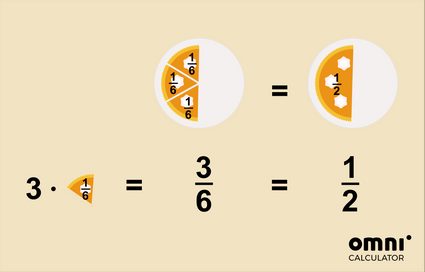
To simplify a fraction, y'all can use two methods:
- Utilise a kind of brute force approach: divide the fraction past 2,3,5,7,11... until it's incommunicable to continue the sectionalization (without a residuum):
42/126 = /:ii
21/63 = /:3
7/21 = /:7
ane/iii
- Find the GCF - greatest common factor of the numerator and denominator, and and then divide them past this number:
GCF(42,126) = 42
42/126 = /:42
1/3
Read more virtually reducing fractions in our defended simplify fractions calculator. Also, make sure to have a look at our amazing equivalent fractions calculator, which can detect many equivalents to your fraction.
How to convert a decimal into fraction?
If y'all want to discover out how to convert a decimal into a fraction, you're in the right place. Here's a step-by-step guide:
Let's assume you desire to convert 0.32 to a fraction:
-
Treat your decimal as a numerator. Then, the denominator will exist 1.
-
Move the decimal dot to the right, till you only take a whole number:
0.32 → 3.2 → 32
Each motion corresponds to multiplication by 10
0.32 * x → three.ii * 10 → 32
- You lot multiplied the numerator by ten * 10, and now we need to multiply the denominator past the same number:
i * x * ten = 100
-
You've inverse your fraction to a decimal!✨
0.32 → 32/100 -
Finally, simplify the result. Every bit the greatest mutual factor for 32 and 100 is four, divide both numerator and denominator by this value:
32/100 = viii/25
And that's information technology, the fraction in its simplest form. ❤️
Merely, if you have a repeating decimal... that's a different story. Have a proficient read of the section , or only use our fraction calculator.
How to plough a fraction into a decimal?
Well, the easiest way to turn a fraction into a decimal is... to use a calculator. Be it this fraction estimator, a standard pocket computer🖩, or our dedicated tool - the fraction to decimal converter.
Sometimes the fraction is relatively easy to alter into decimal without any tools - similar for 1/ii, three/4 (or fifty-fifty 1/8). Nosotros believe that you can figure out how to expand the in a higher place fractions to have 10, 100, thousand, and so on in the denominator, respectively:
- Multiply
1/2by 5, to become 10 equally the denominator:
i/ii = five/10 = 0.5
- Multiply
3/ivpast 25, to get 100 as the denominator:
3/4 = 75/100 = 0.75
- Multiply
one/viiiby 125, to become 1000 as the denominator:
1/8 = 125/1000 = 0.125
But what if you lot don't accept the Internet or a calculator with y'all, but only pen and paper📝? And your fraction doesn't await so easy to expand as the ones above? And then, you lot'll probably demand to practise the long sectionalization to the decimal places by hand. Good luck! 🤞
Source: https://www.omnicalculator.com/math/fraction
0 Response to "what is the first thing you need to do to add one-ninth +start fraction 5 over 6 end fraction ?"
Enregistrer un commentaire